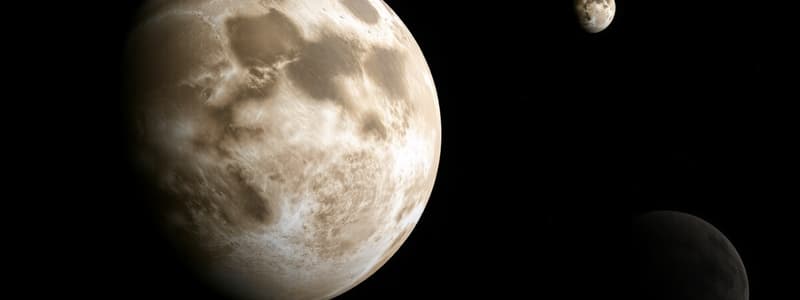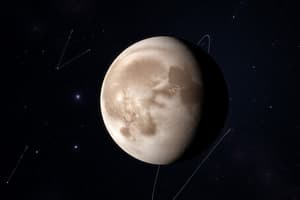Podcast
Questions and Answers
What is the main component of Mercury's atmosphere?
What is the main component of Mercury's atmosphere?
- Nitrogen
- Carbon Dioxide
- Helium
- Oxygen (correct)
Which characteristic best describes Mercury?
Which characteristic best describes Mercury?
- It is the smallest planet in the solar system. (correct)
- It has a dense atmosphere.
- It has the most moons of any planet.
- It is the farthest planet from the Sun.
How long does one day on Mercury last in terms of Earth days?
How long does one day on Mercury last in terms of Earth days?
- 24 Earth days
- 40 Earth days
- 59 Earth days (correct)
- 88 Earth days
What is the main atmospheric component of Venus?
What is the main atmospheric component of Venus?
Which characteristic is unique to Venus compared to other planets in the solar system?
Which characteristic is unique to Venus compared to other planets in the solar system?
Which missions were responsible for exploring Venus?
Which missions were responsible for exploring Venus?
What makes Earth unique among the planets in the solar system?
What makes Earth unique among the planets in the solar system?
Which statement correctly describes Earth's atmosphere?
Which statement correctly describes Earth's atmosphere?
What is a distinctive feature of Earth's surface conditions?
What is a distinctive feature of Earth's surface conditions?
How many moons does Earth have?
How many moons does Earth have?
What is the primary reason that Earth supports life?
What is the primary reason that Earth supports life?
What is the primary component of Mars' atmosphere?
What is the primary component of Mars' atmosphere?
Which feature on Mars is recognized as the largest volcano in the solar system?
Which feature on Mars is recognized as the largest volcano in the solar system?
How many moons does Mars have?
How many moons does Mars have?
Which of the following facts about Mars is true?
Which of the following facts about Mars is true?
What is the origin of the name 'Mars'?
What is the origin of the name 'Mars'?
What is the primary characteristic of Jupiter's surface condition?
What is the primary characteristic of Jupiter's surface condition?
How many known moons does Jupiter have?
How many known moons does Jupiter have?
Which spacecraft were involved in exploring Jupiter?
Which spacecraft were involved in exploring Jupiter?
What unique feature is prominent on Jupiter?
What unique feature is prominent on Jupiter?
Jupiter is named after which figure in mythology?
Jupiter is named after which figure in mythology?
What is the primary composition of Saturn's atmosphere?
What is the primary composition of Saturn's atmosphere?
What is a significant feature of Saturn's rings?
What is a significant feature of Saturn's rings?
How many known moons does Saturn have?
How many known moons does Saturn have?
Which mission is notable for exploring Saturn?
Which mission is notable for exploring Saturn?
What was Saturn named after?
What was Saturn named after?
What is the primary atmospheric composition of Uranus?
What is the primary atmospheric composition of Uranus?
Which characteristic is true about the surface of Uranus?
Which characteristic is true about the surface of Uranus?
What distinguishes Uranus from other planets in the solar system?
What distinguishes Uranus from other planets in the solar system?
How many moons does Uranus have?
How many moons does Uranus have?
What significant space mission provided the first detailed information about Uranus?
What significant space mission provided the first detailed information about Uranus?
What is the primary reason Neptune appears deep blue?
What is the primary reason Neptune appears deep blue?
Which of the following statements is true about Neptune's surface condition?
Which of the following statements is true about Neptune's surface condition?
What unique feature is associated with Neptune in our solar system?
What unique feature is associated with Neptune in our solar system?
Which spacecraft provided significant information about Neptune?
Which spacecraft provided significant information about Neptune?
How many known moons does Neptune have?
How many known moons does Neptune have?
What best describes the surface condition of the dwarf planet?
What best describes the surface condition of the dwarf planet?
What gases are prominently found in the atmosphere of the dwarf planet?
What gases are prominently found in the atmosphere of the dwarf planet?
How many moons does the dwarf planet have?
How many moons does the dwarf planet have?
What is a unique feature of the dwarf planet?
What is a unique feature of the dwarf planet?
Why was the dwarf planet once considered the ninth planet?
Why was the dwarf planet once considered the ninth planet?
Flashcards are hidden until you start studying
Study Notes
Mercury
- Closest planet to the Sun
- Rocky surface
- Thin atmosphere, primarily composed of oxygen
- No moons
- Smallest planet in the solar system
- One day on Mercury lasts 59 Earth days
- MESSENGER spacecraft explored Mercury
Venus: The Sister Planet
- Venus is remarkably similar in size to Earth.
- The surface of Venus is characterized by volcanic activity.
- Venus has a thick atmosphere primarily composed of carbon dioxide.
- Venus has no moons.
- Venus rotates backward compared to most planets in our solar system.
- Spacecraft like Mariner and Akatsuki have explored Venus.
- Venus is named after the Roman goddess of love and beauty.
Earth: The Blue Planet
- Earth is the only known planet in our solar system to support life.
- It has a diverse surface with liquid water, landmasses, and ice caps.
- Earth's atmosphere is primarily composed of nitrogen and oxygen, which are essential for life.
- Earth has one natural satellite, the Moon.
- The presence of liquid water is a key factor for life on Earth.
- Unlike other planets, Earth is not named after a deity.
Mars: The Red Planet
- Mars is known as the Red Planet due to its reddish appearance, caused by iron oxide on the surface.
- The surface of Mars is dusty and dry, with an atmosphere composed primarily of carbon dioxide.
- Mars has two moons, Phobos and Deimos, named after the Greek gods of fear and panic, respectively.
- Mars is home to Olympus Mons, the largest volcano in the solar system, towering 25 km above the Martian surface.
- Mars experiences the largest dust storms in the solar system, sometimes engulfing the entire planet.
- Mars has been explored by numerous rovers, which have provided valuable insights into its geology, climate, and potential for past life.
- The name Mars comes from the Roman god of war, likely due to its reddish color, reminiscent of blood and fire.
Jupiter - The King of Planets
- Jupiter is the largest planet in our solar system.
- Jupiter's surface is gaseous, primarily composed of hydrogen and helium.
- It is home to a massive storm known as the Great Red Spot, which has been raging for centuries.
- Jupiter has a total of 79 known moons.
- It has been explored by spacecraft like Juno and Galileo, providing valuable insights into its composition and atmosphere.
- Jupiter is named after the king of the Roman gods.
Saturn: The Ringed Giant
- Saturn is renowned for its prominent ring system, a defining characteristic of the planet.
- Saturn's surface is a gaseous expanse, resembling its fellow gas giant Jupiter.
- Saturn's atmosphere is primarily composed of hydrogen and helium.
- Saturn boasts a remarkable 83 confirmed moons, a testament to its gravitational influence.
- The planet's rings are a spectacle of cosmic wonder, composed of ice and rock particles.
- The Cassini-Huygens mission provided groundbreaking insights into Saturn and its moons, revealing a treasure trove of scientific data.
- Saturn's name originates from the Roman god of agriculture, reflecting its ancient association with the cycles of nature.
Uranus Overview
- A blue-green ice giant, meaning it's primarily composed of ice and rock
- Possesses a rocky core hidden beneath its icy exterior
- Dominated by an atmosphere primarily consisting of hydrogen, helium, and methane
Uranus's Properties:
- Distinguished by its extremely cold temperatures, making it the coldest planet in our solar system
- Orbits the Sun, accompanied by 27 known moons
Exploration:
- Uranus has been explored through a single flyby by NASA's Voyager 2 spacecraft.
Neptune Overview
- Neptune is the farthest planet from the Sun in our solar system.
- It is an icy giant with a rocky core.
- Neptune's atmosphere consists mainly of hydrogen and helium, with traces of methane giving it its blue color.
- It has 14 known moons.
- Neptune experiences the strongest winds in our solar system.
Exploration
- The only spacecraft to visit Neptune was Voyager 2, which flew past in 1989.
Naming
- Named after the Roman god of the sea, due to its deep blue color.
Dwarf Planet Basics
- Surface primarily composed of ice and rock
- Thin atmosphere contains nitrogen, methane, and carbon monoxide
- Five moons orbit the dwarf planet
- Notable feature: Distinctive heart-shaped glacier
- Historically classified as the ninth planet in the solar system
Studying That Suits You
Use AI to generate personalized quizzes and flashcards to suit your learning preferences.



